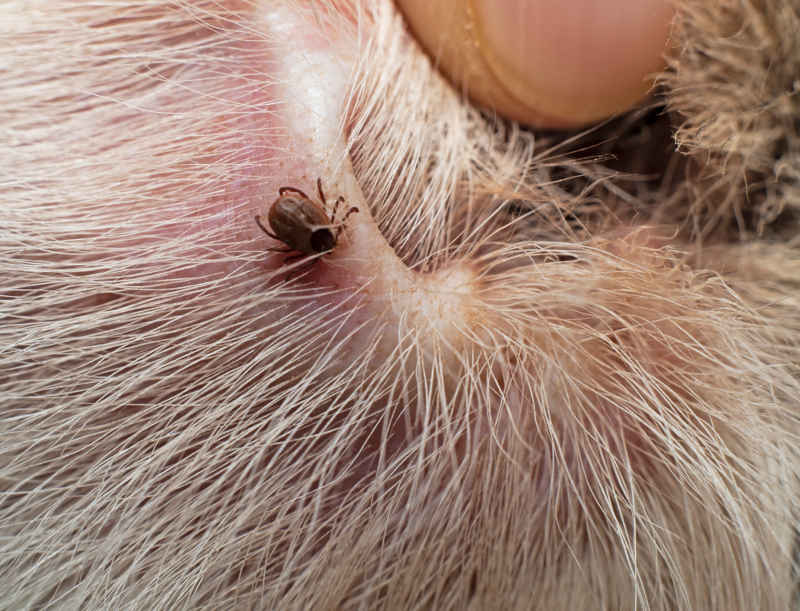
This article was updated on December 17th, 2022
Ticks, skin tags and warts can easily get confused. In this article, we will explain the differences and show you pictures to help you understand what you may have just seen on your dog. We will also explain what to do next to help your dog!
What a Skin Tag Looks Like
A skin tag is a benign growth that develops on the surface of your dog’s skin. They are more common in older animals and large breed dogs, although any dog can develop a skin tag. A skin tag is formed from an overgrowth of collagen and small blood vessels and is essentially a ball of extra skin attached to the surface of your dog.
They do come in a wide range of different sizes and shapes, but many are attached to the skin via a narrow stalk leaving them dangling in space. Below is an example of a very elongated skin tag on a dog:

Below is an example of a skin tag that is more closely “attached” to the skin:

While skin tags are non-cancerous masses that generally don’t cause any harm to your dog, this doesn’t mean that they should be completely ignored. Skin tags often develop on areas of your dog’s skin where there is high friction, such as areas that are in contact with the ground or their collar. Over time constant rubbing of these skin tags will lead to irritation and may be painful for your dog. If your dog keeps rubbing or knocking a skin tag, then it might need to be surgically removed by your veterinarian. Learn more about skin tags in dogs.
What Ticks Look Like [With Pictures]
Ticks can look like warts or skin tags – except that you will be able to see their 6-8 legs spreading on each side as shown in the picture below. Just like skin tags, ticks are often dangling from your dog’s skin (attached by their heads):

They vary in shape, color and size. Below is a small black tick:

A larger brown tick on a dog (with fingers for perspective):

Ticks will also gorge on blood, expanding in size quickly to look like the following:

Ticks can carry diseases or cause infections, so it is important to remove them quickly from your dog. Keep scrolling to view our recommendations for the best way to remove a tick on your dog.
What a Wart Looks Like on a Dog
Dog warts are single or clusters of tiny lumps, which can disappear after a few months. They are occasionally cancerous but are most often benign. Warts can show up as a single small lump:

or as a group or cluster of tiny lumps which look a little bit like a cauliflower floret:

So what’s the difference between a dog wart and a skin tag? Skin tags will be more tear-shaped and hang from a stalk, while warts are rounder, with a thicker base close to the skin. Warts may be darker or lighter than the surrounding skin and skin tags tend to blend in.
The area of your dog’s body can help clue you in as well:
- Warts can be anywhere, but since they come from a contagious virus, they’re more likely to show up on the face and feet, where they come in contact with other dogs.
- Skin tags congregate in areas of friction or irritation, so between the legs and body, on the chest and the lower legs.
Of course, you’ll want your veterinarian to look at any new growth, lump, or bump on your senior dog just to make sure that it isn’t anything to worry about. Learn more about dog warts or find out how to remove dog warts.
How to Remove Ticks, Skin Tags, and Warts
- Ticks: you can’t just pull a tick from your dog without any precautions. If you just try to pull it out with your hands, the tick’s legs and head will likely remain inside your dog’s skin. This can cause infection or inflammation, and be more painful to your dog. Instead, we recommend using a small tool to twist the ticket out, as featured below from Amazon:
You simply slide the tool around the tick, and try to get as close to the skin as possible, to ensure that the tick is trapped within the hook. Twist the tool around several times or until you can feel the ticket loosen its grip. When this happens, you can start pulling the tick out of the skin. If this process causes any difficulty, consult with your veterinarian who will be in the best position to help.
- Skin tags: If you think that a skin tag needs removing because it is bothering your dog or repeatedly getting caught on objects, then there are right and wrong ways to do so. It is not a good idea for a dog owner to try and remove a skin tag at home without the help of a veterinarian. The removal will be painful for your dog, and it will likely create an open wound that is susceptible to infection. Skin tags should only be removed under sedation or a general anesthetic by your veterinarian. Learn more.
- Dog warts: Benign warts usually don’t need any treatment unless they get infected, get in the way, or become irritated. Dogs licking or scratching their warts may end up irritating them. Other damage can also be done by contact with collars or harnesses. Most warts will go away on their own, so the wait-and-see approach is often used. Sometimes a dog will have many warts or they’ll be in places that cause irritation. If this is the case, these warts may be removed surgically. Read our article on how to remove dog warts.
Disclaimer: This website's content is not a substitute for veterinary care. Always consult with your veterinarian for healthcare decisions. Read More.



Be the first to comment